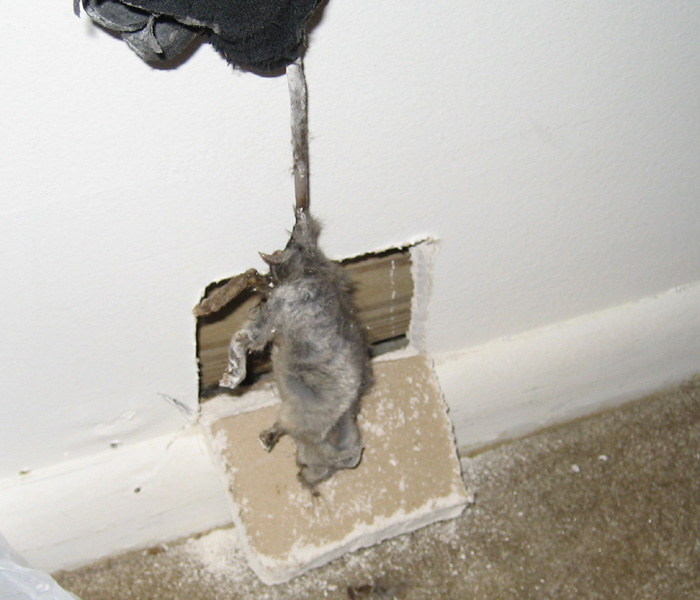- USA Wildlife Removal Education Guide and Resources
Rat in the Wall - What to Do

Removing Rats Inside Your Walls - These sneaky little pests can make their way into almost any cavity in a domestic or commercial property, and with so many modern buildings including cavity walls, it is no surprise that there are increasing numbers of rats living in urban and suburban areas. Wall cavities are also quite difficult areas of a property to get to without causing damage, so when rats do get in there it can be a particular challenge to get them out again. In some cases the rat may have found a way into the cavity but cannot find a way out, while in other situations the cavity may act as a corridor for the rat in its daily journey from place to place.
How Do Rats Get Into The Wall Cavity?
Because rats are flexible and lithe creatures, they will often be able to squeeze through relatively small holes, and it will often require a close examination of a cavity to find the points they are using to get into the cavity. If the noise or scratching coming from the cavity is intermittent, this means that they will usually be moving in and out of that part of the wall, which means the holes are likely to be at ground level or nearby. In some cases, a broken vent a short distance above ground level could also be the culprit, so look for any signs such as rat grease or droppings that might help indicate how the rats are getting into the cavity.
Dealing With A Rat That Is Trapped In A Wall Cavity
Rats will quite rarely become trapped in the wall cavity, but if it does fall from a higher point into the cavity, or manages to block an exit route, you may hear scratching noises that become more frantic as time passes. If you have this situation, you may be able to look down into the cavity from the roof space or the top of the wall, and if this is the case, you may be able to grab the rat using a grab stick to remove it. Where this isn't possible, and there are no obvious ways of opening up a natural access to the cavity, the last option will be to cut a small hole in the wall, but you will need to be very careful to ensure that the rat doesn't escape, and it is trapped and dealt with.
What If The Rats Are Regularly Moving Through The Walls?
Where the rats are regular visitors into the wall cavity, the important first step that you will need to take is to find the entry and exit points, as this is where your efforts will be focused. There are several different ways of dealing with this issue, but the most common method is to trap these rats, and then to seal the wall once you reach a point when you are confident there are no more rats present or getting in and out.
Trapping And Removing Rats Living In The Walls
While rats may be able to make a nest in a wall cavity, they will have to find their way out so that they can gather food, and making sure that there is a snap trap waiting for them is the best way to deal with this. Snap traps are commonly the best option, as they are inexpensive and easy to set, but a body grip trap placed over the entrance to a rat hole can kill the rat. You may need to do this multiple times before you stop catching rats, and once this is done, you can start to repair the damage they have caused.
Dealing With A Rat Carcass In The Wall
The strong scent that comes from a dead rat is something that is unmistakable, and once it has reached a point where you can smell it, other pest animals can smell it too, so you will want to remove it. You may be able to pick it up from the top of the cavity if there is access there with an extendable grab stick, otherwise you may need to look for a vent that can be removed, or even look at cutting a hole to get to the carcass. During the recovery, make sure you don't have direct contact with the carcass, and place it in a sealed container or a double layer trash bag for disposal.
Preventing Rats From Getting In The Wall In Future
The most important thing you can do here is to make sure that the wall is kept in good condition, particularly the exterior, and that all entrance holes are sealed to stop the animals from getting in. If you have any plastic vents, you may also want to cover these in a layer of chicken wire, to help stop the rats from being able to gnaw their way in.
Go back to the main Rat Removal page for more information about what to do if you have rats in your walls. Do you hear scratching sounds in the walls? Is there a dead rat stuck in the wall cavity creating a smell or odor? Or maybe a nest of baby rat in the wall. Can they cause damage, and how do you get rat out of the wall?

